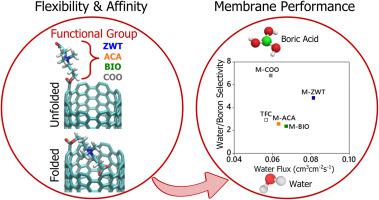当前位置:
X-MOL 学术
›
J. Membr. Sci.
›
论文详情
Our official English website, www.x-mol.net, welcomes your feedback! (Note: you will need to create a separate account there.)
Affinity-based engineering of carbon nanotube embedded polyamide membranes for simultaneous desalination and boron removal
Journal of Membrane Science ( IF 9.5 ) Pub Date : 2024-03-07 , DOI: 10.1016/j.memsci.2024.122636 S. Kürklü-Kocaoğlu , A. Güvensoy-Morkoyun , C. Yıldırım , S. Velioğlu , M.G. Ahunbay , Ş.B. Tantekin-Ersolmaz
Journal of Membrane Science ( IF 9.5 ) Pub Date : 2024-03-07 , DOI: 10.1016/j.memsci.2024.122636 S. Kürklü-Kocaoğlu , A. Güvensoy-Morkoyun , C. Yıldırım , S. Velioğlu , M.G. Ahunbay , Ş.B. Tantekin-Ersolmaz

|
Reverse osmosis (RO) is the leading technology for obtaining drinking and irrigation water from seawater. Although currently developed RO membranes achieve high salt rejection; several challenges exist, such as permselectivity trade-off, biological/chemical contamination, and insufficient retention of small and neutral molecules like boric acid. Due to its toxicity to living organisms and strictly monitored levels in potable water, removal of boron has gained considerable attention in RO industry. Thin film nanocomposite (TFN) membranes have emerged by incorporating nanomaterials with superior water/salt selectivity into polyamide (PA) layer of composite membranes. For the first time, our group investigated the potential of carboxylated carbon nanotube (CNT) embedding in the selective layer of TFN membranes for boron removal. Within this frame, we hypothesize that embedding fillers with low boron affinity accompanied by high water permeability in the selective layer of TFN membranes improves boron removal without suffering from the permselectivity trade-off. In this study, we investigated the boron removal performance of functionalized CNT (f-CNT) embedded TFN membranes. Initially, CNTs were functionalized with three different functional groups (namely, biotin (BIO), 8-amino caprylic acid (ACA), and zwitterion (ZWT)) to narrow down the tube entrance, provide repulsive electrostatic interactions with boron, and interfere with the hydrogen bonding between water and boric acid molecules. Then, TFN membranes incorporating f-CNTs were fabricated, characterized, and tested. Showing high compatibility with PA, ZWT functionalization has increased water/boron selectivity of TFN membranes by 66% and water permeability by 44%, while maintaining the salt rejection at 98%. Furthermore, we employed molecular dynamics simulations and potential of mean force calculations to elucidate the boron exclusion mechanism in f-CNTs. With its flexible structure and “gate-keeper” ability, ZWT functional group was found to show the highest energy barrier against boron transport. Hence, engineering CNT/PA TFN membranes to promote steric hindrance and decrease solute affinity is promising for efficient removal of detrimental small molecules from seawater.
中文翻译:

基于亲和力的碳纳米管嵌入聚酰胺膜工程,用于同时脱盐和除硼
反渗透 (RO) 是从海水中获取饮用水和灌溉水的领先技术。尽管目前开发的RO膜实现了较高的脱盐率;存在一些挑战,例如选择性渗透权衡、生物/化学污染以及硼酸等小分子和中性分子的保留不足。由于其对生物体的毒性以及饮用水中硼含量的严格监控,硼的去除在反渗透行业中引起了相当大的关注。通过将具有优异的水/盐选择性的纳米材料掺入复合膜的聚酰胺(PA)层中,出现了薄膜纳米复合(TFN)膜。我们的团队首次研究了将羧化碳纳米管 (CNT) 嵌入 TFN 膜选择性层中去除硼的潜力。在此框架内,我们假设在 TFN 膜的选择性层中嵌入具有低硼亲和力且具有高水渗透性的填料可以改善硼的去除,而不会受到选择性渗透的影响。在这项研究中,我们研究了嵌入功能化碳纳米管(f-CNT)的 TFN 膜的除硼性能。最初,碳纳米管被三种不同的官能团(即生物素(BIO)、8-氨基辛酸(ACA)和两性离子(ZWT))功能化,以缩小管入口,提供与硼的排斥静电相互作用,并干扰水和硼酸分子之间的氢键。然后,制造、表征并测试了包含 f-CNT 的 TFN 膜。 ZWT 功能化与 PA 表现出高度相容性,可将 TFN 膜的水/硼选择性提高 66%,透水率提高 44%,同时将脱盐率保持在 98%。此外,我们采用分子动力学模拟和平均力计算的潜力来阐明 f-CNT 中的硼排除机制。凭借其灵活的结构和“看门人”能力,ZWT 官能团被发现对硼传输表现出最高的能垒。因此,工程化 CNT/PA TFN 膜以促进空间位阻并降低溶质亲和力有望有效去除海水中的有害小分子。
更新日期:2024-03-07
中文翻译:

基于亲和力的碳纳米管嵌入聚酰胺膜工程,用于同时脱盐和除硼
反渗透 (RO) 是从海水中获取饮用水和灌溉水的领先技术。尽管目前开发的RO膜实现了较高的脱盐率;存在一些挑战,例如选择性渗透权衡、生物/化学污染以及硼酸等小分子和中性分子的保留不足。由于其对生物体的毒性以及饮用水中硼含量的严格监控,硼的去除在反渗透行业中引起了相当大的关注。通过将具有优异的水/盐选择性的纳米材料掺入复合膜的聚酰胺(PA)层中,出现了薄膜纳米复合(TFN)膜。我们的团队首次研究了将羧化碳纳米管 (CNT) 嵌入 TFN 膜选择性层中去除硼的潜力。在此框架内,我们假设在 TFN 膜的选择性层中嵌入具有低硼亲和力且具有高水渗透性的填料可以改善硼的去除,而不会受到选择性渗透的影响。在这项研究中,我们研究了嵌入功能化碳纳米管(f-CNT)的 TFN 膜的除硼性能。最初,碳纳米管被三种不同的官能团(即生物素(BIO)、8-氨基辛酸(ACA)和两性离子(ZWT))功能化,以缩小管入口,提供与硼的排斥静电相互作用,并干扰水和硼酸分子之间的氢键。然后,制造、表征并测试了包含 f-CNT 的 TFN 膜。 ZWT 功能化与 PA 表现出高度相容性,可将 TFN 膜的水/硼选择性提高 66%,透水率提高 44%,同时将脱盐率保持在 98%。此外,我们采用分子动力学模拟和平均力计算的潜力来阐明 f-CNT 中的硼排除机制。凭借其灵活的结构和“看门人”能力,ZWT 官能团被发现对硼传输表现出最高的能垒。因此,工程化 CNT/PA TFN 膜以促进空间位阻并降低溶质亲和力有望有效去除海水中的有害小分子。



























 京公网安备 11010802027423号
京公网安备 11010802027423号